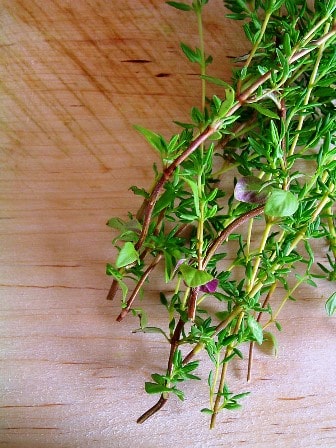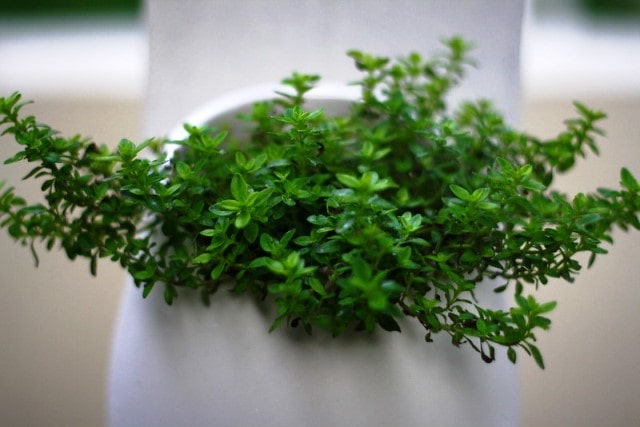Thyme is popularly known for its fresh aroma. Its flower, leaves, and oil are mainly used to flavor foods.
Thyme is very special for those who love to cook. Adding thyme to dishes can enhance the taste of the dish.
Another great thing about thyme is that it has chemicals that will significantly help reduce symptoms of bacterial and fungal infections.
If you like to add Thyme to your food every time, buying each time can be expensive. So, it’s best to grow thyme in your garden.
Thyme is relatively easy to grow and requires less attention. The best thing is it can grow in any climate. But if you stay in warm areas, it will grow as an annual herb, whereas in cold regions, it will grow as a perennial herb.
The article discusses how to grow thyme from store-bought thyme. So, keep reading this article to learn much more about the propagation of thyme plants in your garden.
MORE POSTS: How to grow mint from store bought mint?
What Are The Different Varieties Of Thyme?
1. German Winter Thyme
The German winter thyme has small green leaves and is quite famous for its culinary flavor.
2. Citrus Scented Thyme
There are mainly three types of citrus-scented thyme, i.e., orange, lemon, and lime. Lime thyme has a distinct lime flavor, and the foliage color is light green.
If we talk about orange thyme, it will have an orange flavor. The leaves are green and small. Whenever you crush lime thyme with orange thyme then, it will produce a nice flavor. People usually use these scented thymes while making herbal teas.
3. Transparent Yellow
The transparent yellow thyme is popularly known for culinary and ornamental purposes.
4. Silver Edge
Silver edge thyme is mainly used for ornamental purposes. But you can use them for eating purposes. The foliage is small and silver-white and helps to beautify your garden.
5. French
French thyme can be easily grown in your garden. The foliage of this thyme is dark green and will calm your eyes.
6. Foxley
The foliage of the Foxley is creamy white, and you can use it both for ornamental and culinary purposes.
How To Grow Thyme From Store-Bought Thyme?
There are various ways of propagating thyme. For instance, you can grow thyme from seeds. But it takes a longer time to germinate and grow.
The best way to grow thyme is through its cuttings. You can easily get fresh green cuttings from the grocery store. If you have a small space in your garden or don’t have much time to look to plant, you can grow thyme cuttings even in a glass jar containing water. You will get fresh herbs throughout the year.
We are discussing below step by step how to grow thyme from store-bought thyme.

1. Choose Thyme For Planting
Your first step is to choose healthy and young thyme branches for propagation. If you have woody branches, then don’t choose them for planting. Remember, the branches should be at least 6 inches long. If you grow thyme from cuttings, it will propagate like its mother plant.
2. Remove The Leaves From The Bottom Of The Branch
Your next duty will be to remove the bottom leaves from the branch. It will encourage the branch to propagate or grow later.
You have to then cut the tip of the branch at a 45-degree angle to help grow the plant.
3. Dip The Growth Hormone
Sometimes you want the roots to emerge very fast from the branches. In such a case, you must dip the bare branches into the rooting hormone. This process is optional, and you can skip it.
4. Start Planting
Your next duty is to fill a pot with good-quality potting soil. Ensure that the pot has enough drainage holes to drain out excess water.
You can take a small pot at this stage as the branches will be too small. But when the roots emerge, you can shift it to a large pot.
Now gently place the branches on the soil and give some water. You can place the pot indoors to prevent the last frost. Place the thyme outside when the frost gets over.
If you decide not to use growth hormone, then it’s best to grow thyme plants in a glass containing water. The roots will start to appear from branches within 3-4 weeks.
5. Transplant
You have to transplant the thyme plant when it reaches a height of 12 inches. Try to transplant the plant entirely in your garden.
You need to check various locations and place the plant where the thyme plant will get a good amount of sunlight.
Additionally, remember that thyme plants will not grow in wet soil. So, you must choose where the soil can quickly drain the excess water.
Remember that the soil temperature needs to be within 70-80 degrees Fahrenheit for proper plant growth.
How Can I Take Care Of My Thyme Plant?
You have to water your thyme plant when the soil has become dry. You can easily check the soil mixture with your finger. Insert your finger inside the soil, and if it comes dry, then water your plant. We recommend deep watering your thyme plant so that it will grow properly. You have to also prune the plant from time to time.
Additionally, spread mulch near the thyme plant, particularly in the cold winter season, so that it will retain moisture.
Weeds may grow near the thyme plant and can steal all the nutrients. So try to remove the weeds near the thyme plant.
When the thyme plant is three years old, replace it with a new one. It is because old leaves will not have much good aroma. The soil PH should be between 6.5 to 7 for proper plant growth.
The best soil for thyme is sandy loam soil which is rich in nutrients. Keep them in water for a few days and you will see roots coming out. Do not forget to change the water regularly. If you do not change the water regularly, the fungus may grow and rot the cuttings.
What Are The Common Insects That Can Attack Thyme Plants?
1. Aphids
Aphids are small insects and are generally white or brown. They usually live under the leaves and try to suck the juice, which can weaken the plant.
Well, you can make a mixture of alcohol and water in a ratio of 1:1 and spray it over the leaves. You can then spray neem oil on the leaves, a great way to avoid aphids.
2. Spider Mites
If you visualize any web covers on the leaves of your aphids, then you will understand that spider mites attack the thyme plant. These insects also suck the juice from the leaves of the plant. You can spray neem oil to avoid spider mites.
3. Common Diseases
Root rot and alternative bright are the most common fungal diseases that attack aphids.
What Are The Tips To Prevent Thyme From Spreading Fungal Diseases?
Below are a few tips to prevent your thyme plant from spreading fungal diseases.
- You have to keep an eye on the thyme plant, and if you see any affected part, then remove it with the help of a scissor.
- You can use stakes if required for proper plant growth.
- Try to do pruning from time to time to avoid excess growth.
- Mulching is also needed from time to time to prevent fungal spores.
How Can I Harvest Thyme?

Below are a few tips you need to follow while harvesting thyme plants.
- You have to cut 5-6 inches of the thyme plant. But try to leave the lower part of the stem.
- Try to harvest mainly in the morning.
- The thyme plant will start to bloom white or pink flowers. But if you are growing thyme, especially for culinary purposes, harvest it before the flowers open.
- The flavor of the thyme leaves will not get affected even if the flower starts to bloom.
- You have to trim the plant frequently for proper plant growth.
How Can I Store Thyme?
Storing fresh thyme in the refrigerator is better if you have plucked fresh thyme. But before keeping it, you must remove old and yellow leaves from the branches.
Some people may be interested in preserving thyme in dry form. You can hang the thyme in a warm, dark, ventilated space for a few days.
Keep the leaves in a dry, air-tight container whenever you find them dry so you can use them in the future. Crush thyme leaves whenever you want to use them in any food items for flavor.
Freezing thyme is also another storage option to keep the dried leaves for a longer time.
Conclusion
Thyme is one of the best herbs that can be used for culinary and medicinal purposes. You can grow them in your garden despite having a small space.
The best thing is you can propagate thyme easily from the thyme branches which you have brought from the store.
We have discussed above how to grow thyme from store-bought thyme and regarding harvesting. The leaves grow all over the year, and you can harvest fresh green leaves and add them to soups or any other favorite foods. The fresh thyme leaves will add an excellent aroma to the food.
